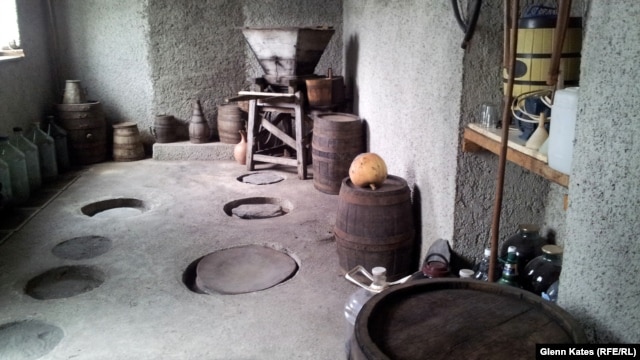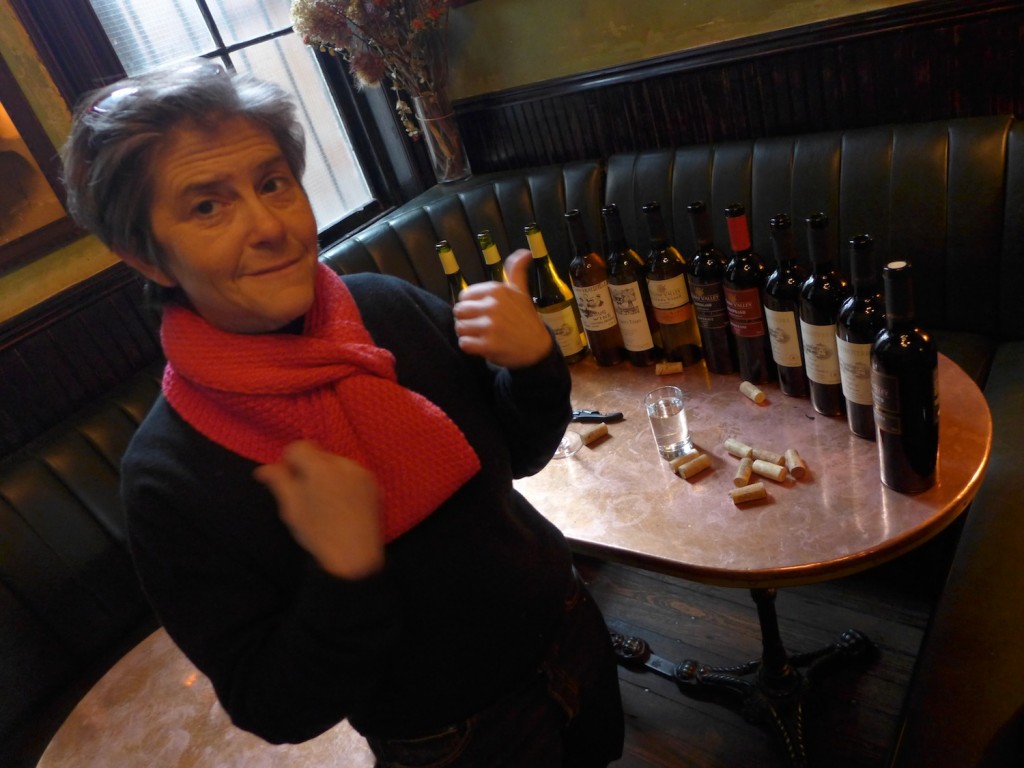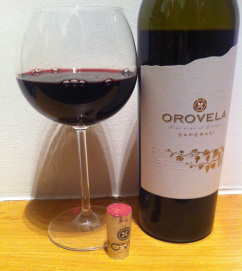23.12.2013. After 'North' and 'South' came 'East and West'. Kind of predictable but as one expert fretted, 'West' was going to be tricky given that only non-vinifera and hybrid varieties could be said to originate there if by West one meant America.
Not to be daunted by trifle like that, the organisers of this tasting decided to focus on the Seven Percenters of California - the growers who make wine from grapes other than Cabernet Sauvignon, Merlot, Pinot Noir, Chardonnay, Zinfandel and the like plus a Baco Noir from Oregon.
Perhaps more by bad luck, the East didn't shine on this occasion and it was the West that provided the best and most popular wine.
The two absolute favourites, satifyingly enough, represented both sides. From the East, Verdernikov's Krasnostop Zolotovsky (Rostov-on-Don) was a big hit and the Forlorn Hope 'Suspiro del Moro' Alvarelhao was so popular a second bottle had to be opened. The winners on both sides were:
EastMavrud. This Bulgarian speciality really shone. The other Bulgarian favourite, Melnik came second being rather over tannic in comparison. The Bulgarian crosses were disappointing.
The Georgians failed to hit their usual mark which was quite a surprise and the Hungarians were also surprisingly disappointing. This was bad luck because we have tasted fabulous examples of many of these wines previously as you can see by entering the names some of these grapes in our Search Engine.
Nonetheless the Chkaveri proved quite a lot of fun. At first, this light Georgian wine didn't offer up all its charms as they say but the next day it was hard to resist.The Shavkapito wasn't bad either.
The Koshu was just a bit too delicate in this context and the other Russians - Tsimlyansky, Aligote and above all Sibirkory suffered from bad corking we suspect.
Neither the Rara Neagru nor the Bastardo did much to promote the image of Moldova or Crimea but it has to be said the Bastardo improved with air contact.
Krasnostop Zolotovsky. This is a winner in anyone's language. We have paid tribute to its softness and fruitiness before. This example did not disappoint.
WestAlverelhao. Slotovino's Red wine of the year, 2012/13. We have gone on rather a lot about this Forlorn Hope star, but as far as we are concerned there is no limit to the praise the 'Suspiro del Moro' is worth.
Verdelho. Another case of a late developer. The Forlorn Hope Verdelho 'Que Saudade' was not immediately appealing but once opened, it began a remarkable development which lasted more than a week under Vac-U-Vin.
Forlorn Hope's Trousseau Gris ('Trou Grit') was more immediately appealing. What a lovely corrective to overpowering Californian fruit bombs!
Charbono. Not as obscure as it sounds, this is the Bonarda of Argentina. This Napa Valley example was very appealing.
Why do we like Baco Noir so much? It tastes of Hybrid but there is something moreish in its meaty appeal. We would have said it is an acquired taste were it not for the fact we have liked it from the off.
Teroldego. We have seen Teroldego from Brazil. This Californian one showedhow successful it can be away from the Campo Rotaliano.
Similarly, Californian Torrontes can stand up to Argentinian ones it seems.
Trousseau. Placed next to the Bastardo from Crimea, one was hard put to tell the two were made from the same grape. This Arnot Roberts Natural version was light and quaffable. We had hoped never to use that word but quaffable was what this wine is.
There were very decent examples of Aglianico, Negrette and Touriga Nacional (although we have tasted sensational Californian Touriga previously).
We weren't exactly bowled over by the Valdiguie at first. This Paul Matthew Turner wine really grew on you. Although over 14%, we kept on returning for an extra sip.
It was good to have not one but two examples of Counoise in purezza (something we had never encountered in Europe). The Pinotage and Tannat hardly rose above what might be called generic Californian.
There was also a Cabernet Pfeffer. This fabled obscurity was more interesting as a mystery than for its taste (slightly herbacious a la Carmenere and indeed Cabernet Gernischt if you ask). As you can see from the back label, the producer, the estimable Kenneth Volk who specialises in the 7% varieties states that Cabernet Pfeffer was a Bordeaux variety named for its pepperiness. Actuallyhis Cabernet Pfeffer vines are the same as the obscure Bordelais variety Gros Verdot. There actually was a grape breeder called William Pfeffer who made a cross between Cabernet Sauvignon and some unidentified variety in the 1880s but these were all wiped out by Phylloxera. Subsequently in the 1890s, he is reported to have grafted a better version of a seedling on to American rootstocks. 'Wine Grapes' to whom as ever we are endebted for this information has been in touch with Kenneth Volk but the situation is still not clear. There might be both Gros Verdot and William Pfeffer's cross in his vineyard. No matter: on the strength of this example, it is unlikely anyone will buy multiple bottles unless for the purposes of flummoxing MW exam candidates or stumping one's friends.
Here's the list in full:
EastBulgaria
Istoria Bez Kray BOUQUET (Pinot Noir x Mavrud cross) Thracian Valley 2010. 12.5%
Borovitsa EVMOLPIA (Mavrud x Merlot cross) and MERLOT, Thrace, 2011. 12.5%
Borovitsa GAMZA (aka. KADARKA), Thrace, 2009. 12.5%
Mz Winery, Enigma MAVRUD 2006. 13%
Logodaj MELNIK Nobile, Thracian Valley, 2008. 14%
Georgia
Iago’s Wine CHINURI Chadarchi, (without skin contact), 2010. 11.41%
Iago’s Wine CHINURI Chadarchi, (with skin contact), 2009. 13.25%
Bagdati CHKEVERI, (qvevri), 2010. 11.5%
Pheasant’s Tears SHAVKAPITO, Mukhrani, Kartli, 2010. 12.5%
Hungary
Frittman Selection Barrique EZERJÖ Kunsag, 2011
Gelleripince JUFARK, Balatonfured, 12%
Szrelmey Elso Magyar Borhaz KEKNYELU, Badacsonytomaj. 2009, 13.5%
Boranal Kft. KADARKA, Kunsag 2012, 11.5%
Japan
Grace Vineyards Kayagatake KOSHU 2011. 11.5%
Moldova
Vinaria Purcari RARA NEAGRA DE PURCARI (aka. Babeasca Neagra), Purcari 2011. 13%
Russia
Vedernikov Vineyards SIBIRKORY, Rostov on Don 2010. 12.5%
Pravoberezhnoe ALIGOTE, Vedernikov region 2008. 12.5%
KRASNOSTOP ZOLOTOVSKY, Vedernikov region, 2010, 14.5%
Vedernikov Vineyards TSIMLYANSKY CHERNY, Rostov on Don, 2010. 13%
Ukraine
Inkerman BASTARDO (aka. Trousseau). Crimea, 2011. “9.5% – 12%”
WestForlorn Hope Trou Grit TROUSSEAU GRIS, California 2012. 10.57%
Bray Vineyards VERDELHO, Shenandoah Valley, California. 2011. 14.4%
Forlorn Hope Que Saudade VERDELHO California 2011. 13.9%
Caparone Paso Robles Estate AGLIANICO, California 2009. 13.4%
Forlorn Hope, Suspiro del Moro, ALVARELHAO, California 2012 . 12.05%
Girardet BACO NOIR, Umpqua Valley Oregon 2011. 13.8%
Forlorn Hope, San Hercurmer delle Frecce BARBERA Amador County, California 2011. 13.9%
Ken Volk CABERNET PFEFFER San Benito County California 2008. 13.82%
Fable Napa Valley CHARBONO 2010. 12.7%
Frick Winery, Owl Hill Vineyard Estate COUNOISE, California 2010. 13.9%
Writer’s Block COUNOISE, Steele Lake County California 2010. 13.5%
Kenneth Volk Calleri Vineyard NEGRETTE, San Benito County California 2009. 14.8%
Moonstone Crossing John Bree Vineyards PINOTAGE, Amador County, California 2008. 15.2%
Ursa Vineyards Silvaspoons Vineyard TANNAT, Lodi, California 2006. 14.8%
Urban Legend Holland Landing Vineyard TEROLDEGO, California 2009. 14.2%
Pierce Ranch, TOURIGA NACIONAL, San Antonio, California 2008. 14.4%
Arnot Roberts Luchsinger Vineyard TROUSSEAU (aka. BASTARDO), Clear Lake, California 2011. 12.3%
Paul Matthew Turner Vineyards VALDIGUIÉ, Knights Valley California 2012. 14.1%
Source











.jpg)


.jpg)
















